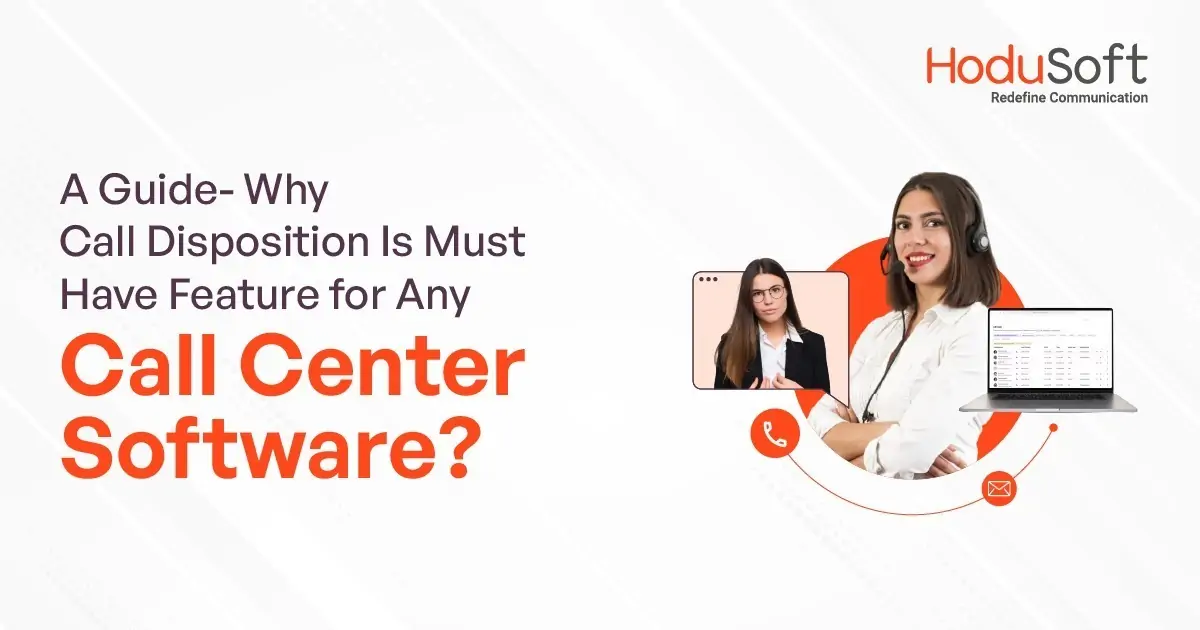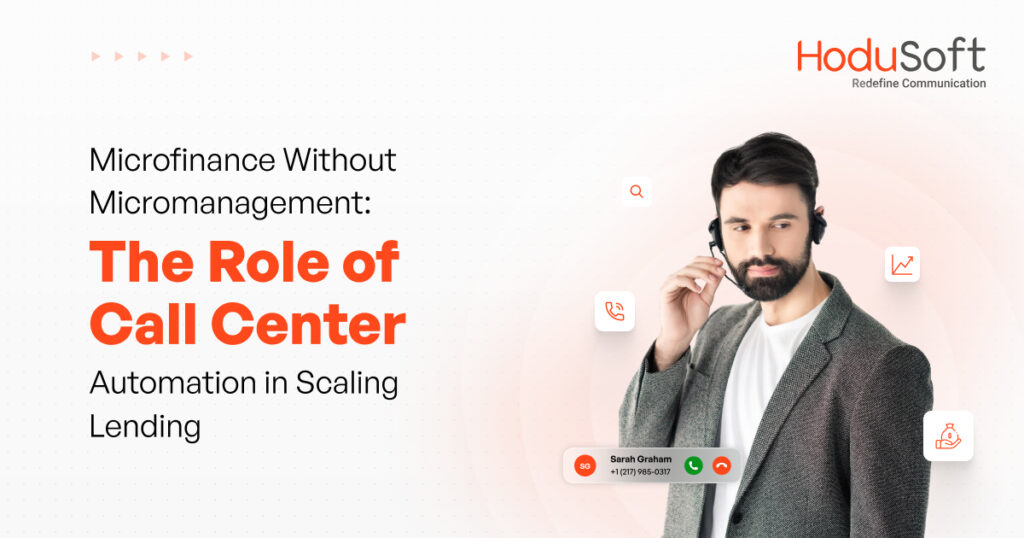A Guide- Why Call Disposition Is A Must Have Feature for Any Call Center Software?
We have witnessed a dramatic shift in consumer behavior in recent times. Nudged by the Covid-19 pandemic, accelerated digitization, and changing economic environment, consumers are now weighing every spend carefully. Organizations are sensing the change and upgrading their call center software. However, the road ahead is not easy.
A survey by Deloitte indicates 80% of companies now plan to close their physical customer service centers entirely. With 77% of service organizations either adopting or accelerating their work-from-home programs, managing, monitoring, and measuring operations remotely will be a major challenge.
In a general scenario, both outbound call center software and inbound call center software are used by companies to manage their customer service operations. Most operators of call center systems rely on KPIs (Key Performance Indicators) or metrics to assess the performance of employees.
On average, a customer sales agent spends considerable time logging details. In fact, the stringent enforcement of reporting led to 62% of representatives logging more details about customer interaction than in 2019, according to a Salesforce report. To support this complex architecture and customer service needs, organizations are falling back on call disposition. Let’s understand its definition and benefits in detail.
- What is a Call Disposition?
- Why Is Call Disposition Useful in Call Center Software?
- How Does the Call Disposition Feature Work?
- What Are the Common Call Disposition Codes?
- Tips to Create Your Own Call Disposition Code
- Benefits of Call Disposition in Call Center Software
- How Does Single-Click Call Disposition Work in HoduCC?
What is a Call Disposition?
What is a Call Disposition?
A call disposition is a simple way of recording the outcome of every call with preset tags. If we talk about what is a disposition in a call center, then it usually refers to the outcome or result of a customer interaction, such as a phone call or chat session. It is a categorization of the call or interaction, used to track and analyze customer behavior and agent performance.
A call disposition is a simple way of recording the outcome of every call with preset tags. If we talk about what is a disposition in a call center, then it usually refers to the outcome or result of a customer interaction, such as a phone call or chat session. It is a categorization of the call or interaction, used to track and analyze customer behavior and agent performance.
Call disposition functions as a reporting tool to understand consumer behavior and agent performance. At the same time, it reduces the time and effort to manually log details and saves crucial time for service agents who can focus on relationship building and sales.
Aiding it is a call disposition list, which is a system to categorize and track the outcome of each phone call or interaction. By using a call disposition list, organizations can streamline their customer service process to categorize and track the outcome of each interaction.
To know the efficacy of call disposition initiatives, organizations use call disposition reports to gain valuable insights into customer interactions, analyze trends, and improve their service or sales strategies.
Why Is Call Disposition Useful in Call Center Software?
Call disposition function is certainly a valuable feature in call center software. It assists organizations to track and manage the outcome or status of each customer interaction.
Using this feature, call center agents and managers can easily categorize and document the results of every call. This useful information can be used for analysis, reporting, and decision-making purposes.
Call disposition can be used together with CRM (Customer Relationship Management) software or as an independent tool in call center software. Several top call center software has different ways of defining the metrics, which may take some time for the agents to master.
Most call center systems have either all or majority of the following metrics:
- Scheduled appointments
- Product demonstrations or service call booking
- Lead data quality
- Lead Follow-up schedules
- Voicemail history
- Lead status
- Number of voicemails left
- Data on new and old sales leads generated through conversations
- First Call Resolution (FCR) rate
How Does the Call Disposition Feature Work?
The call disposition feature in call center software allows agents to categorize and log the outcome of customer interaction. It is a must-have feature for any call center software because it provides valuable insights into customer behavior and agent performance, thereby helping businesses to optimize their operations and improve the customer experience.
Call disposition codes are typically predefined or customized by the call center. When an agent completes a call, they can select the appropriate disposition code, which is then recorded in the call center software.
What Are the Common Call Disposition Codes?
Call disposition codes can vary depending on the specific industry, organization, or call center software used. However, here are some common call disposition codes that are often used in call center operations:
- Resolved: When the call was addressed successfully and the customer’s query was resolved.
- Not Resolved: When the call did not result in a resolution for the customer. It means that further action or follow-up is required.
- Escalated: If the call was escalated to a higher level of support to address the customer’s concern.
- Callback Scheduled: When a follow-up callback is required to address the customer’s issue or inquiry at a later time.
- No Answer: When the call was not answered by the customer.
- Sales Opportunity: When the customer expressed interest in buying a product or service. It means that there is a potential sales opportunity.
- Voicemail Left: When the call was forwarded to voicemail and a message was left to address the concern of the customer.
- Wrong Number: When the call was considered to be a wrong number or not relevant to the company’s services.
- Customer Disconnected: When the call was disconnected by the customer before the issue was resolved.
- Not Interested: When the customer conveyed disinterest or declined the offer, product, or service presented during the call.
- Follow-up Required: When a call requires a follow-up or further interaction with the customer to address their concern.
- Technical Issue: If the call was related to a technical problem or technical support request.
- General Inquiry: When the call was related to a general inquiry or request for information.
- Complaint: When the call involved a customer complaint related to the company’s product, service, or support.
These are just a few examples of call disposition codes that companies can use. Organizations can even customize their codes based on their specific requirements and goals.
Top Call Center Metrics and KPIs to Every Business Should Track
Tips to Create Your Own Call Disposition Code
Creating your own call disposition code is quite an easy task. You just need to keep in mind the following steps:
Determine your objectives:
Firstly, determine your goals and objectives for using call disposition codes. It is important to consider the type of information you need to gather, track, and analyze.
Evaluate the types of calls and their outcomes:
By analyzing the types of calls that your call center generally manages and the possible outcomes of those calls, you will be able to create different categories.
Categorize different calls:
Based on the call outcomes, group them into relevant categories. Make sure that the category is clear, different, and covers different outcomes perfectly.
Assign code labels:
Assign distinctive labels or codes to each call disposition category. The labels should be short and easy to understand.
Document the code meanings:
For a better understanding of what each code represents, make sure to draft a reference document or guide. This guide will help your call center agents to understand and use the codes correctly.
Provide training to your agents:
Conduct training sessions to explain to your call center agents the importance of using the codes consistently and precisely.
Include the codes in your call center software:
You can also configure your call center software to include different types of call disposition codes.
Review and evaluate your codes:
It is vital to review and determine the effectiveness of your call disposition codes regularly. If required, make adjustments or refinements to the codes.
While creating the call disposition codes, focus on your company’s specific needs and objectives. Creating the right and meaningful codes will help you in capturing the outcomes of customer interactions accurately. It will further help in tracking the performance, measuring key metrics, and making informed decisions to enhance the overall performance of your call center.
Benefits of Call Disposition in Call Center Software
The benefits of call disposition for a call center are numerous. Some of the key benefits include:
Better decision-making ability
Call disposition for a call center provides managers with real-time data on customer behavior and agent performance, allowing for better decision-making and continuous improvement.
Helps in identifying issues more effectively
Analysis of disposition data can reveal common issues that customers are calling about, allowing the business to address these issues more effectively. It can also help identify training needs for agents and opportunities for process improvements.
Accurate tracking and reporting of call center metrics
Another benefit of call disposition is that it allows for more accurate tracking and reporting of call center metrics, such as average handle time, first call resolution, and customer satisfaction. This data can be used to identify areas for improvement and set performance goals for agents.
Keep vital information of customers updated
The call disposition generally has details such as the type of call, agenda of the call, taken action, future action, etc. Keeping the code of conduct to fill up this information after a call would hardly take a few minutes, but it will keep the records of communication with the caller up to date, which can be used for a variety of productive reasons.
Handle calls in a personalized way
The call disposition will help you to record all vital information about the last call to the caller. This will keep all relevant information for each caller/customer in line so whenever the next time the same person calls, your agents, supervisors, and other staff members have handy information about the customer and his/ her last call. So they can serve them in a personalized manner. This will help in serving customers in a better way to gain customer loyalty and satisfaction.
Timely follow-up
The call disposition will also record the details for the next action item. So if the next action item is to reach the caller again on a given date and time, then your staff will be able to do that in time. Even the system can be programmed to generate an outbound call at that specific time and date.
Align customer analytics with outbound calling campaigns
As the call disposition will allow you to record information in detail, you can use these details to segment your customer according to their preference, interest, buying habits, etc. With this segmented list, you can design more strategic outbound campaigns and run them more specifically to gain better returns and output.
Automate call log-in process
Whether we consider the top management of a call center or a supervisor leading a team of call center agents, both need handy information for quick supervision. The call disposition will provide all the necessary details to review different things easily and quickly.
Overall, call disposition is a critical feature for any call center software as it provides valuable insights into customer behavior and agent performance, allowing businesses to optimize their operations and improve the customer experience.
HoduSoft’s award-winning call center software HoduCC features in-built CRM and calls disposition. In case you own CRM, the integration is seamless with HoduCC, which plugs the call data into CRM software automatically.
How Does Single-Click Call Disposition Work in HoduCC?
The single-click call disposition feature in HoduCC helps to simplify and speed up the process of logging call dispositions. With this feature, call center agents can log the outcome of a call with a single click, rather than having to navigate through multiple screens and options.
As soon as the customer service agent ends the call, single-click call disposition facilitates agents to record the call results instantaneously. A series of drop-down menus helps in faster recording of the call results and brings clarity to the agent who may be busy with an exhaustive call list.
Each selection of drop-down options follows the preset menu to accurately identify the issue or concern and then categorize it. Overall, the single-click call disposition feature assures:
Easy Team Management
Team managers can simply browse through the call deposition data to segregate high-potential prospects and inactive prospects. The actions, such as email follow-up, in-person meetings, or direct calls, can be taken for each prospect and can be personalized based on reviews and feedback from customer service agents.
Easy CRM Integration
Easy integration with most of the leading CRMs means as soon as the ticket is generated in CRM, agents can simply connect with the customer by clicking, without having to dial the number manually. The call disposition record leads to higher accuracy and better measurement of performance.
Takeaway
Now that you understand what is a disposition in a call center, you must include this feature in your call center software. Choosing the right software with a call disposition feature can help you get valuable information for analysis, reporting, and decision-making in the call center environment.
If you are still indecisive about call center software with a call disposition feature, let’s connect. We have the trust of over 200 customers across 6 continents and 34 countries. Feature-rich and fully customizable, HoduCC is the best call center software available at an unmatched value.



